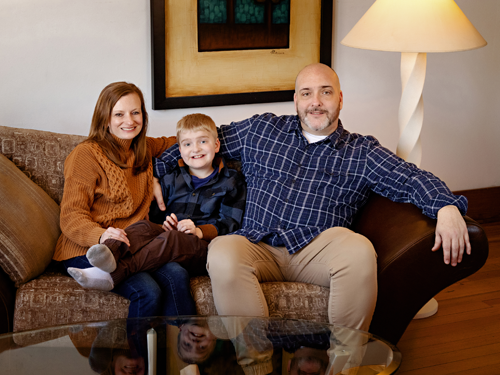
Landry Wardlow is a playful 10-year-old from Iowa. He takes swimming lessons, likes outings to the zoo, spends cold winter nights doing art projects and hot summer days killing time at his brothers’ baseball tournaments. Typical kid stuff.
But Landry lives with Duchenne muscular dystrophy and his journey is far from ordinary. In addition to navigating life with a rare genetic disease, he is a pioneer in the new era of drug development. That’s because Landry recently participated in a groundbreaking clinical trial that incorporated a wearable device.
After he was diagnosed with Duchenne at age 4, Landry’s mom, Holly, dedicated herself to researching treatment options and finding a clinical trial that might help stop the disease progression. In late 2021, Landry enrolled in a Phase 3 trial for Sarepta’s investigational gene therapy for Duchenne. According to topline results from that trial, participants saw meaningful improvements in something called stride velocity 95th centile, or SV95C.1 SV95C is a measure of how fast someone walks, and it is captured via small wearable devices on each ankle.
The integration of SV95C into the Sarepta trial showcases the potential for wearables in drug development and represents an important milestone in Duchenne research. “Because wearables record daily movement over a period of time, the data is not affected by how motivated or tired a patient may feel during a specific clinic visit. Researchers get a more complete view of a how a therapy is impacting a trial participant,” said Stefanie Mason, M.D., senior medical director at Sarepta.
“It’s a way to gather insights from outside of the clinic and in a way that is less intrusive. It helps us adapt a study to a participant’s life rather than the other way around,” she continued. “Gene therapy is groundbreaking, but when you add this type of technology that can provide us with real-time, real-world insights, it’s exciting.”
When it came to the small Velcro devices he wore on both ankles, Landry wasn’t focused on the scientific significance of it. His take was simpler: “My doctor wants to know how fast I can run.”
Accelerating new treatments
Fitness trackers and smart watches have become a part of everyday life. Beyond tracking our workouts and sleep, wearable devices are increasingly important in clinical trials and drug development because they capture continuous data on participants’ health and activities.
Landry, for example, wore his ankle devices all day for three weeks at a time several times during the trial. The wearables captured how many steps he took over the course of a day and how fast the steps were. Holly would put the devices on in the morning and only take them off for swimming lessons and at bedtime. They were a part of Landry’s daily routine and captured whatever the day might bring – moving around his classroom, swinging at recess, trips to an amusement park or just sitting on the couch. At night, each device went on a charger to transmit the collected data. “It captured more of a realistic day for him,” Holly said.
Research shows that children with Duchenne take fewer steps overall and fewer steps at moderate and high rates than children without Duchenne.2 As the disease progresses, step count and stride speed decreases until children lose the ability to walk altogether. “Capturing continuous SV95C data can tell us if a person’s maximum stride speed is declining, stabilizing or even improving over time,” explained Dr. Mason. “That provides valuable information about the disease progression and whether an investigative therapy is working as intended.”
Also, because wearable devices can gather so much data over the course of a day, they may pave the way for faster trials, according to Craig McDonald, M.D., professor and chair of the UC Davis Health Department of Physical Medicine and Rehabilitation and an investigator in the study.
“The volume of data helps researchers to promptly identify treatment efficacy and trends,” he said. “Eventually, that may help shorten clinical trial durations and speed the availability of new treatments – something that is especially important for people living with progressive diseases.”
What is SV95C?
- Stride velocity 95th centile, SV95C, is a digital measure of peak ambulatory performance.
- More simply: A wearable device tracks an individual’s steps and the speed of those steps. SV95C refers to the speed of the fastest 5% of strides taken by the wearer over a defined period of time.3
Reducing clinical trial burden

Landry’s trial was conducted at the Center for Pediatric Neuromuscular Disorders at Washington University in St. Louis, a six-hour drive from his Iowa home. Each time they had to make the trip to St. Louis, Holly or her husband would load Landry in the car by 5 am. Then a quick lunch after the visit, and right back in the car for the drive home. They were long, tiring days for all.
In the future, wearables might decrease the need for clinic-based appointments and decrease the burden on participants like the Wardlows. “If wearable devices can provide insights into a child’s ambulatory status and functional strength remotely, we may be able to reduce the number of in-person visits,” Dr. McDonald said. “Simplifying trial participation may encourage broader and more diverse participation, crucial in rare disease trials with small patient populations.”
“Embracing novel digital endpoints and integrating wearable devices isn’t just a technological leap, it’s a demonstration of our dedication to putting patients first,” Dr. Mason said. “By harnessing leading-edge digital solutions, we aim to make the clinical trial experience more patient-centric than ever before, accelerate the pace of innovation and expedite the delivery of transformative treatments to patients.”
According to Holly, capturing the complete picture of a child with Duchenne is what’s most important. If a wearable device can help researchers see beyond Landry’s performance on a functional assessment in the clinic, to how he now runs at recess with a friend; or how he climbs up play equipment at the park and climbs down the bus steps without assistance; or fights with his brothers and has an ordinary day, that’s the true sign of progress and hope.
How does SV95C fit into clinical trials?
- SV95C was accepted by the FDA in the Sarepta trial as a secondary endpoint. (In clinical trials, secondary endpoints support a therapy’s claim of efficacy by demonstrating additional clinical effects.)
- However, in other parts of the world, SV95C is accepted as a primary endpoint in clinical trials.
- The European Medicines Association (EMA), the agency of the European Union in charge of the evaluation and approval of pharmaceutical products, recently approved SV95C as a qualified primary endpoint for Duchenne patients 4 years and older.4
- That means the data gathered from the wearable device can serve as the main outcome measure used to determine whether the treatment has a significant and clinically meaningful effect.
- The EMA noted that SV95C may be used as an alternative to the six-minute walking test (6MWT), a common functional assessment used to evaluate the mobility of Duchenne patients.
References
1. Sarepta Therapeutics Announces Topline Results from EMBARK, a Global Pivotal Study of ELEVIDYS Gene Therapy for Duchenne Muscular Dystrophy. https://investorrelations.sarepta.com/news-releases/news-release-details/sarepta-therapeutics-announces-topline-results-embark-global-0
2. McDonald CM, Widman LM, Walsh DD, Walsh SA, Abresch RT. Use of step activity monitoring for continuous physical activity assessment in boys with Duchenne muscular dystrophy. Arch Phys Med Rehabil. 2005 Apr;86(4):802-8. doi: 10.1016/j.apmr.2004.10.012. PMID: 15827935.
3. Servais L, Yen K, Guridi M, Lukawy J, Vissière D, Strijbos P. Stride Velocity 95th Centile: Insights into Gaining Regulatory Qualification of the First Wearable-Derived Digital Endpoint for use in Duchenne Muscular Dystrophy Trials. J Neuromuscul Dis. 2022;9(2):335-346. doi: 10.3233/JND-210743.
4. European Medicines Agency, Committee for Medicinal Products in Human Use. Qualification Opinoin for Stride velocity 95th centile as primary endpoints in studies in ambulatory Duchenne Muscular Dystrophy Studies. https://www.ema.europa.eu/en/documents/scientific-guideline/qualification-opinion-stride-velocity-95th-centile-primary-endpoint-studies-ambulatory-duchenne-muscular-dystrophy-studies_en.pdf
